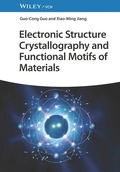Electronic Structure Crystallography and Functional Motifs of Materials

1. Auflage Februar 2024
240 Seiten, Hardcover
Monographie
ISBN:
978-3-527-35220-3
Wiley-VCH, Weinheim
Kurzbeschreibung
Contains the fundamental electronic structure concepts of functional materials, important for the studies of the structure-property relationship and structure design of functional materials.
Jetzt kaufen
Preis: 139,00 €
Preis inkl. MwSt, zzgl. Versand
Euro-Preise für Wiley-VCH- und Ernst & Sohn-Titel sind nur für Deutschland gültig. In EU-Ländern gilt die lokale Mehrwertsteuer. Portokosten werden berechnet.
CHAPTER 1 OVERVIEW OF ELECTRONIC STRUCTURE CRYSTALLOGRAPHY
1.1 Introduction
1.2 History of Electronic Structure Crystallography
1.3 Basic Descriptors of Electronic Structure
1.4 Experimental Characterization of Electronic Structure
References
CHAPTER 2 FIRST-PRINCIPLE CALCULATION OF THE ELECTRON DENSITY FUNCTIONS
2.1 Introduction
2.2 Basic Framework and Assumptions of the First-Principle Calculations
2.3 Density Matrix and Density Function
2.4 Hartree-Fock (HF) and Kohn-Sham (KS) Methods
References
CHAPTER 3 TOPOLOGICAL INDICIES AND PROPERTIES OF ELECTRONIC STRUCTURES
3.1 Introduction
3.2 Analysis of Topological Atoms in Molecules
3.3 Chemical Interaction Analysis
3.4 Coarse Graining and Energy Partition of the Density Matrix
3.5 Restricted Space Partition
3.6 Intermolecular Interaction Energy
References
CHAPTER 4 PRINCIPLES OF ELECTRONIC STRUCTURE MEASUREMENT
4.1 Introduction
4.2 Thermal Vibration Analysis
4.3 Scattering Experiments
4.4 Refinement Algorithm for Experimental Electronic Structure
References
CHAPTER 5 PSEUDOATOM MODEL
5.1 Introduction
5.2 Independent Atom Model
5.3 Kappa Model
5.4 Multipole Model
5.5 Spin Density Model
5.6 Other Electron Density Models
References
CHAPTER 6 DENSITY MATRIX MODEL
6.1 Introduction
6.2 Density Matrix Model
6.3 Correlation of Density Matrix to Scattering Experiments
6.4 Reconstruction and Refinement of the Density Matrix
References
CHAPTER 7 ELECTRON WAVEFUNCTION MODELS
7.1 Introduction
7.2 X-Ray Constrained Wavefunction (XCW) Model
7.3 The X-Ray Constrained Extremely Localized Molecular Orbital Method
References
CHAPTER 8 FUNCTIONAL ELECTRONIC STRUCTURES AND FUNCTIONAL MOTIF OF MATERIALS
8.1 Introduction
8.2 Material Functional Motif
8.3 Functional Electronic Structures
8.4 Function-oriented Design of Functional Materials
References
1.1 Introduction
1.2 History of Electronic Structure Crystallography
1.3 Basic Descriptors of Electronic Structure
1.4 Experimental Characterization of Electronic Structure
References
CHAPTER 2 FIRST-PRINCIPLE CALCULATION OF THE ELECTRON DENSITY FUNCTIONS
2.1 Introduction
2.2 Basic Framework and Assumptions of the First-Principle Calculations
2.3 Density Matrix and Density Function
2.4 Hartree-Fock (HF) and Kohn-Sham (KS) Methods
References
CHAPTER 3 TOPOLOGICAL INDICIES AND PROPERTIES OF ELECTRONIC STRUCTURES
3.1 Introduction
3.2 Analysis of Topological Atoms in Molecules
3.3 Chemical Interaction Analysis
3.4 Coarse Graining and Energy Partition of the Density Matrix
3.5 Restricted Space Partition
3.6 Intermolecular Interaction Energy
References
CHAPTER 4 PRINCIPLES OF ELECTRONIC STRUCTURE MEASUREMENT
4.1 Introduction
4.2 Thermal Vibration Analysis
4.3 Scattering Experiments
4.4 Refinement Algorithm for Experimental Electronic Structure
References
CHAPTER 5 PSEUDOATOM MODEL
5.1 Introduction
5.2 Independent Atom Model
5.3 Kappa Model
5.4 Multipole Model
5.5 Spin Density Model
5.6 Other Electron Density Models
References
CHAPTER 6 DENSITY MATRIX MODEL
6.1 Introduction
6.2 Density Matrix Model
6.3 Correlation of Density Matrix to Scattering Experiments
6.4 Reconstruction and Refinement of the Density Matrix
References
CHAPTER 7 ELECTRON WAVEFUNCTION MODELS
7.1 Introduction
7.2 X-Ray Constrained Wavefunction (XCW) Model
7.3 The X-Ray Constrained Extremely Localized Molecular Orbital Method
References
CHAPTER 8 FUNCTIONAL ELECTRONIC STRUCTURES AND FUNCTIONAL MOTIF OF MATERIALS
8.1 Introduction
8.2 Material Functional Motif
8.3 Functional Electronic Structures
8.4 Function-oriented Design of Functional Materials
References
Prof. Guo-Cong Guo is Director of the State Key Lab of Structural Chemistry at Fujian Institute of Research on the Structure of Matter (FJIRSM), Chinese Academy of Sciences, Fuzhou, P. R. China. He obtained his Ph.D. from the Chinese University of Hong Kong under the supervision of Professor Thomas Chung Wai Mak in 1999. His main research interests include structural chemistry and functional materials (photochromic, nonlinear optical, and nano-catalytic materials).
Ass. Prof. Xiao-Ming Jiang received his Ph.D. in 2011 from the Fujian Institute of Research on the Structure of Matter with a major in inorganic chemistry, the Chinese Academy of Sciences. Then he worked as a postdoctoral fellow at the School of Physics at Nanjing University and the School of Chemistry at the Technical University of Munich (Germany) in sequence. In 2016, he joined FJIRSM and focused his research interests on the experimental electronic structure study of functional materials covering nonlinear optical, magnetic, and ferroelectric materials and so on.
Ass. Prof. Xiao-Ming Jiang received his Ph.D. in 2011 from the Fujian Institute of Research on the Structure of Matter with a major in inorganic chemistry, the Chinese Academy of Sciences. Then he worked as a postdoctoral fellow at the School of Physics at Nanjing University and the School of Chemistry at the Technical University of Munich (Germany) in sequence. In 2016, he joined FJIRSM and focused his research interests on the experimental electronic structure study of functional materials covering nonlinear optical, magnetic, and ferroelectric materials and so on.


